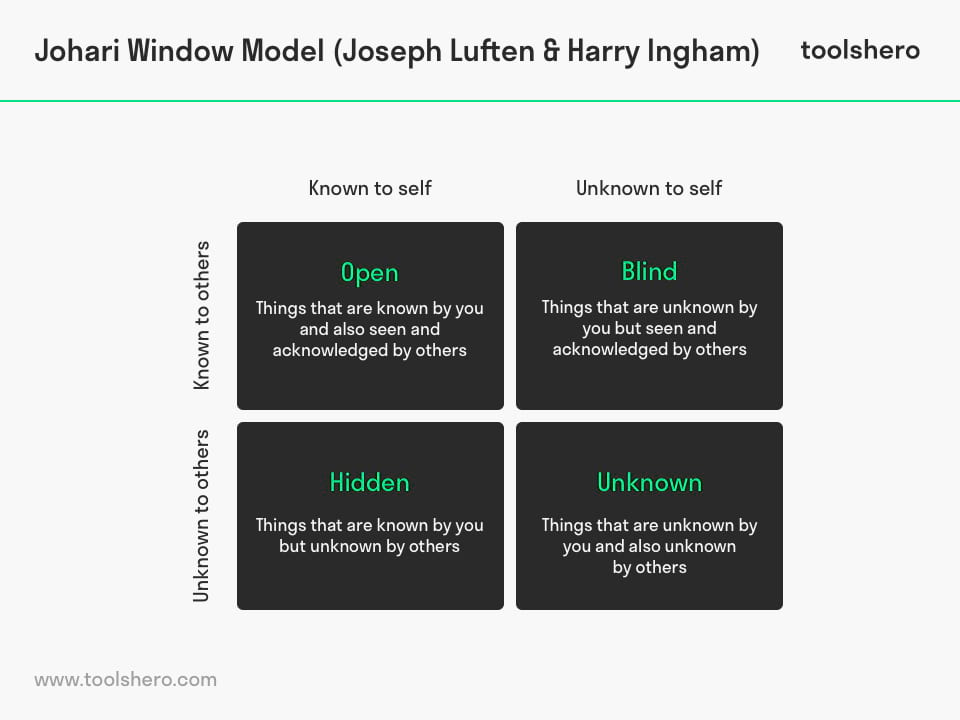Johari Window Model explained

Johari Window Model: this article describes the Johari Window Model, developed by psychologists Joseph Luft and Harry Ingham in 1955 in a practical way. After reading you will understand the basics of this Communication Skills and Coaching tool, a video eplanantion with an example, how to use the model, and a Johari Window Model template. Enjoy reading!
What is the Johari Window Model? The theory
When someone exhibits behaviour that is perceived to be disturbing by their environment, it is good to give them feedback on it. For many, it can be very difficult to confront others on their behaviour. People are not always aware of their own behaviour, or perhaps they are aware of their behaviour, but will not easily admit it.
Feedback is a good way to confront someone on their (disturbing) behaviour. The Johari window can help with this, as it provides insight into the behaviour of yourself and others.
Johari Window Model video (in-depth explainer) with an example
Watch the in-depth video below for a recap of what you’ve just read, so you will remember it more easily!
The Johari Window Model explained
The Johari model is a practical tool to illustrate and improve self awareness and mutual understanding between individuals, for example team members.
The model is useful when it comes to improving intergroup development and interpersonal development. It can also help to improve intergroup relationships and group dynamics. Because of this, the model is often used to support team development.
The Johari window model was created in 1955 by Joseph Luften and Harrington Ingham. This happened while researching group dynamics at the University of California. The name is derived from the first names of the creators. The Johari window can help people to better understand their communication with others.

Figure 1 – The Johari window model four quadrants explained.
4 Quadrants
The Johari window model has four quadrants, or four window panes, that represent four combinations. Here we explain the Johari window with personal examples.
1. Open Space: Known to you – Known to others
This Open Space or open area is about the behaviour that is known by you and also seen and acknowledged by others. You can communicate about this.
Still, it sometimes happens that there is behaviour that is disturbing to the environment, where someone is aware that it is. Patience and caution are important when discussing this behaviour with someone.
The open quadrant corresponds to all the things everyone knows about you. For example, a carpenter and the people around him know that he is a specialist in making window frames. Besides that, they know that he loves beautifully finished products, respects others and always makes time to help others.
2. Blind Spot: Unknown to yourself – Known to others
The blind area quadrant of the Johari Window represents things you don’t know about yourself, but others do. For example, it can happen that a new employee is late for a meeting.
The person moderating the meeting answers the questions briefly and returns to where the meeting left off. The new employee later comes to the moderator and tells him that what he did was rude.
The moderator explains to the new employee that he may have appeared curt. This is because he started the meeting on time for those who really needed it.
In this way, the moderator indicates something to the new employee that he did not know before, so that the employee can take his blind behaviour into account in future interactions.
The Blind Spot or blind area can be very difficult to manage, and can cause others to talk about you.
This is because they can see something that you don’t. Perspiration odour, the frequent use of the same word or continuous pulling of the nose are other examples of this.
The Blind Spot can also occur in the working environment. Someone can be unaware of the fact that he works slower than his colleagues. Others are aware of this, however, which can cause certain irritations. If feedback is not given properly to another, he will stay stuck in his old behaviour and is likely to fall outside the group.
3. Hidden Area: Known to yourself – Unknown to others
In the Hidden Area, people can keep certain personal information to themselves and not share it with others. The office clerk can keep hidden from his colleagues that in his free time he is a jazz guitarist.
The Hidden Area can also be unknown to a limited number of other people. The same office clerk may have a good colleague with whom he does share his hobby, making it a subject for communication. In that case, this Hidden Area slowly shifts to Open Space.
So the hidden quadrant contains things that you know yourself, but others don’t. Self-disclosure increases through interaction, creating potential to learn about where someone grew up, what family values someone was taught and what experiences someone has had.
As soon as one person learns more about another person, this hidden window gets smaller and the open window gets bigger.
4. Unknown Area: Unknown to yourself – Unknown to others
No communication exists about this Unknown Area. Purely because of the fact that both parties are unaware of it, which means it won’t become the subject of discussion.
The unknown quadrant contains information about a person’s behaviour, beliefs and feelings. These are not known to anyone, including the person in question. There are many situations wherein a person’s strengths and weaknesses first come to the fore. For example, how does an intern react to his or her first overtime?
Use of the Johari Window Model
Most people try to communicate using only the Open Space. Eye contact, body language and styles of communication are overlooked. Hiding feelings or thoughts from others can create challenging moments of communications that are criticized by others who might see something incorrectly.
A person with healthy self-esteem can respond in a way that reveals something from the Blind Spot.
If a person is open to constructive criticism, the information moves to the Open Space / open area and healthy interaction can take place. Everyone has different styles of communication, different temperaments and personal stressors that are often kept out of professional life.
The Johari Window Model is effective in helping to understand the relationship between employee and employer and to help build trust.
It is also referred to as a disclosure model, or self awareness model, as an extension of emotional intelligence. For some people, the method serves as an information processing aid and increases self awareness.
This window represents information about experiences, attitudes, skills and motivations of a particular person in relation to the group that person is in. This information is described from four perspectives, whereby it becomes clear which information is or is not known to the person himself and/or to others.
The Johari Window Model can be used to describe the same information about a group in relation to another group as well.
Feedback
Without addressing the behaviour that can cause irritation or annoyance, this may lead to misunderstanding, uneven relationships and a tense atmosphere. Behaviour in the Blind Spot is particularly difficult to discuss with others.
Through feedback rules, the message feels less harsh and the recipient won’t feel as attacked. As a result, he is more likely to become aware of his behaviour.
In addition, good feedback results in mutual understanding, joint agreements and pleasant cooperation. The basic rule for feedback is to communicate from your own experience: the I message.
As soon as this is left out, the other person can feel particularly attacked. “I noticed that you didn’t get the job done yesterday” goes over better than “you didn’t get the job done yesterday”. Then the other can be asked if this finding is correct and whether he has also noticed the same.
Throughout the conversation, the I-message is crucial. When the other person is aware (and, as it were, he shifts from a Blind Spot to an Open Space), the time is right to look at possible solutions together.
Giving compliments also helps to keep the atmosphere pleasant: “I’m happy that you also noticed it and I’m curious to hear if you have an idea on how to prevent this in the future”. Talking to each other leads to good ideas that are acceptable to the person being addressed and that make him feel comfortable. The Open Space is now complete and the issue can be openly discussed.
When behaviour that can cause irritation or annoyance is not addressed, this may lead to misunderstanding, uneven relationships and a tense atmosphere. Behaviour in the Blind Spot of the Johari Window is particularly difficult to discuss with others.
Through feedback rules, the message feels less harsh and the recipient won’t feel as attacked. As a result, he is more likely to become aware of his behavior. In addition, good feedback results in mutual understanding, joint agreements and pleasant cooperation.
The basic rule for feedback is to communicate from your own experience; the I-message. As soon as this is left out, the other person can feel particularly attacked. “I noticed that you didn’t get the job done yesterday” goes over better than “you didn’t get the job done yesterday”. Then the other can be asked if this finding is correct and whether he has also noticed the same.
Throughout the conversation, the I-message is crucial. When the other person is aware (and, as it were, he shifts from a Blind Spot to an Open Space), the time is right to look at possible solutions together.
Giving compliments also helps to keep the atmosphere pleasant: “I’m happy that you also noticed it and I’m curious to hear if you have an idea on how to prevent this in the future”.
Talking to each other leads to good ideas that are acceptable to the person being addressed and that make him feel comfortable. The Open Space is now complete and the issue can be openly discussed.
Confidential
Despite the Johari window being a basis for clear information, this does not, of course, mean that everything needs to be discussed publicly. Even when information is in the Open Space, this can also be confidential information that does not need to be made public.
In that case, it is about information that can or cannot be made public. Even in the example of the office clerk who plays jazz guitar in his free time, it is possible that he told his colleague this in confidence. He may have asked his colleague not to share this with their other colleagues. He can have various reasons for doing so, such as privacy, shame, not wanting to share, etc.
Mutual Trust
The Johari Window is useful to gain insight into your behaviour and that of others. It provides you with information about the relationships with others and gives you the opportunity to improve yourself. By broadening the Open Space and reducing the hidden, and being continuously aware of this, the mutual trust with others will only increase.
The Blind Spot and Hidden Space are shrinking if there is more knowledge of each other and one is going to discuss matters in an open way. This tool is very effective and can, among others, be used for small conflicts, negotiations or lack of understanding towards each other.
By openly asking questions and engaging with each other, the various parties can discover what the underlying ideas, opinions and motives were that led to this behaviour. The Blind Spot moves to an Open Space and people will have increased respect for each other’s opinions.
Johari Window template
Want to improve your communication skills? Get insights into your own behaviour and communication with others by using this ready to use Johari Window Model template. For inspiration, please refer to the Johari window with personal examples in this article.
Download the Johari Window template
This template is exclusively for our paying Toolshero members. Click here to see if a membership is something for you!Now it’s Your Turn
What do you think? Is the Johari Window Model applicable in your daily work? What is your experience with Feedback and Behaviour techniques? Do you recognize the practical explanation or do you have more additions? What are your success factors for giving and receiving Feedback in relation to certain behaviour?
Share your experience and knowledge in the comments box below.
More information
- Luft, J., & Ingham, H. (1961). The Johari Window. Human Relations Training News, 5(1), 6-7.
- Luft, J., & Ingham, H. (1955). The Johari Window, a graphic model of interpersonal awareness. Proceedings of the Western Training Laboratory in Group Development. Los Angeles: University of California, Los Angeles.
- Luft, J., & Ingham, H. (1961). The Johari Window: a graphic model of awareness in interpersonal relations. Human relations training news, 5(9), 6-7.
- Smith, R. E., Carraher, E., & DeLisle, P. Johari Window Model. Leading Collaborative Architectural Practice, 221-224.
- Verklan, M. T. (2007). Johari Window: a model for communicating to each other. The Journal of perinatal & neonatal nursing, 21(2), 173-174.
How to cite this article:
Mulder, P. (2020). Johari Window Model. Retrieved [insert date] from Toolshero: https://www.toolshero.com/communication-methods/johari-window-model/
Original publication date: 07/28/2020 | Last update: 12/09/2023
Add a link to this page on your website:
<a href=”https://www.toolshero.com/communication-methods/johari-window-model/”>Toolshero: Johari Window Model</a>













4 responses to “Johari Window Model explained”
Well written & translated. This model works with mutual understanding and can broaden horizons of personal growth and development amongst one another. However, the 3rd quadrant – the Hidden square – needs more explaining and how it can contribute to one’s growth
Thank you for your comment, Akshita.
Ex, quadrant 3: Definitely there are some things that should be kept hidden. For example, if you had diarrhea last night or you have a crush on a married co-worker, don’t share.
Thank you .The article is highly informative.